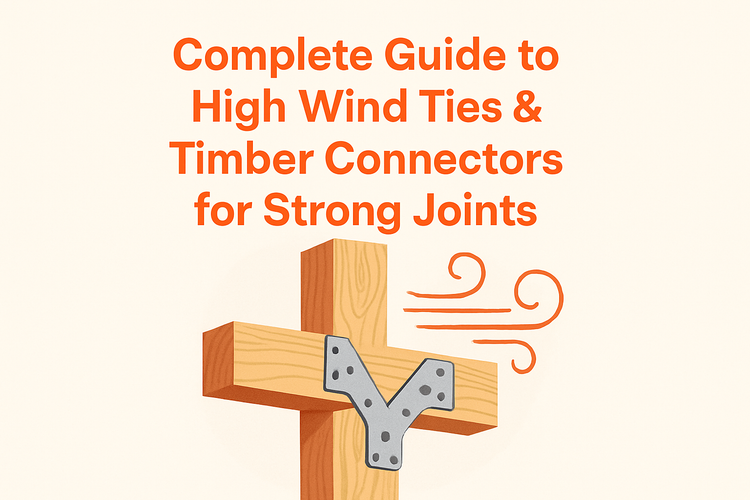Complete Guide To High Wind Ties & Timber Connectors For Strong Joints

Understanding High Wind Tie Requirements for Structural Stability
High wind conditions pose a unique challenge to any timber structure. To ensure buildings stay intact, it is crucial to understand the importance of high wind ties and where they are most effective.
High wind ties are metal connectors designed specifically to resist the uplift and lateral forces created by strong wind loads. These forces can cause structural damage if the components of a timber frame—such as walls, roofs, and floors—are not adequately tied down or connected. Proper use of these connectors ensures building elements remain unified under stress, minimizing potential failure during extreme weather events.
Specifying the correct high wind tie products is usually determined by a combination of wind zone classification, build type, and timber size. Engineers and builders must often consult building regulations and technical documentation when selecting the appropriate tie or fastener. Many timber frame connectors are also tested to British or European structural standards, ensuring reliability when installed as recommended.
An important step in achieving structural compliance is selecting certified components from trusted ranges. The High Wind ties & timber connectors category effectively addresses these concerns, offering carefully engineered products designed to meet demanding structural codes.
Choosing the Right Timber Connector for Joint Strength
Not all connectors are created equal. Selecting the right timber connector is essential for both safety and structural longevity.
Timber connectors vary significantly in form and purpose; some are designed for load-bearing joints like beams and rafters, while others reinforce shear wall performance during lateral wind forces. Brackets, ties, plates, and fasteners work in unison to deliver overall strength. For timber frame structures, using matched components designed to function together can prevent connection fatigue or the possibility of joint separation, particularly in exposed locations such as coastal or upland areas where gusts are regular.
For heavily stressed joints—like those between rafters and beam supports—integrating metal Timber Frame Connectors with high-grade screws or nails is essential. These hardware sets distribute force across wider surface areas, preserving the timber's structural properties even under repeated stress cycles. Certain connectors can also improve fire resistance and acoustic insulation properties, depending on their installation design.
Notably, some timber connectors are designed with dual purposes in mind. A single high wind tie or plate may offer uplift protection and shear resistance simultaneously. Understanding this duality helps reduce on-site material complexity and speeds up the build process without compromising safety.
Integrating Post Base Anchors for Ground-Level Wind Uplift Protection
Post bases do more than provide aesthetic elevation. They are a frontline defense against wind uplift forces on vertical timber posts.
At ground level, wind loading can lift vertical posts right out of the ground, especially when positioned under patios, pergolas, or open-planned structural extensions. The right Post Base anchors serve both structural and moisture prevention functions. These connectors stabilize upright timber members to concrete or steel foundations, while creating necessary separation from moisture that may rise through the footing or slab.
Many modern post bases now come with adjustable heights and integrated lateral bracing elements. These features allow accurate fitments during uneven flooring or outdoor landscaping changes. More importantly, by anchoring posts securely and permitting minor movement without disconnection, these bases mitigate cracking or pulling in joints above.
Whether you are using 100x100mm fence uprights or larger structural posts, always ensure the fixings are rated for your wind zone. High wind regions demand robust, corrosion-resistant fasteners to maintain integrity long-term. Looking for durable components? The High Wind ties & timber connectors collection includes compatible tie-downs for base anchors.
Securing Roof Structures with Coordinated Timber Connectors
Roofs are particularly vulnerable during high wind events and require reinforced joinery systems to withstand uplift and pressure.
Utilizing a coordinated system of connectors, hangers, and straps across any timber roof assemblage is a major step in promoting long-term stability. Roof trusses, purlins, and ridge beams all require structured tie-downs, often involving angled plates or heavy-duty hurricane ties. These not only secure members together but also transfer wind pressures safely down into the lower structure.
For trussed roofs, rafter-tail connections and ridge board fixings are critical. Using compatible products from the Joist Hangers and High Wind ties & timber connectors categories gives peace of mind that your materials will perform as intended. Many of these products also include countersunk screw points and reinforced steel for maximum shear strength.
Don't overlook restraint straps along roof cavities, especially in double-pitched constructions. These essential components tie the roof to adjacent walls, limiting lateral shift and preventing collapse under swirling or shifting wind patterns. Ensuring every connection is specified correctly avoids expensive afterbuild corrections.
Best Practices for Installing Wind-Resistant Connectors
Even the best connectors can fail if not installed properly. Correct fitting techniques amplify the strength and durability of any wind-resistant system.
The first rule is ensuring that all fasteners, such as nails and screws, are fitted according to the manufacturer’s guidelines. Over-driving fasteners or misaligning plates can reduce mechanical retention and increase the likelihood of failure. Using hardware from the Screws and nails selection ensures compatibility with timber joints and metalloids used in high tensile wind ties.
Marking and pre-positioning connectors before full nailing prevents misalignment after pressure is applied. In particular, angle brackets and corner ties should tightly hug the timber surface to avoid creating voids or wiggle space. Such defects can become fail points under repeated wind pulsations over time.
Lastly, double-check location specifics: every high wind product performs best in particular layouts. Lightweight strap ties may be preferable for framing internal partitions, while massive down-hold anchors work best near end-grain post connections. Always match your connector type with building zone, timber load, and exposure level using high-rated products from the High Wind ties & timber connectors inventory.
